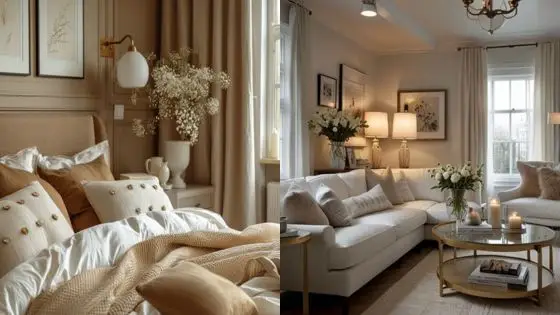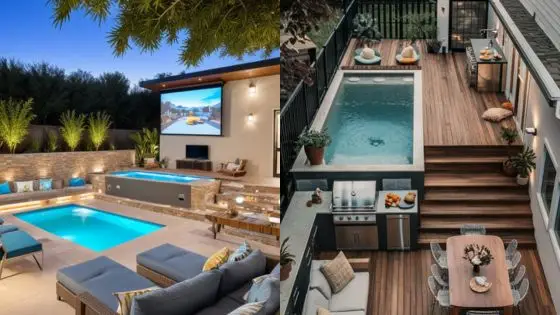When it comes to home design philosophy, few debates spark as much passion as minimalism versus cozy clutter. Each represents a distinct approach to creating your living space and reflects deeper values about consumption, comfort, and personal expression. Both minimalism and cozy clutter can create beautiful, functional homes—the best choice depends on your personality, lifestyle needs, and what genuinely makes you feel at peace in your space.
Walking into a minimalist home feels like taking a deep breath—clean lines, intentional possessions, and open space create a sense of calm and order. Contrast this with the warm embrace of a cozily cluttered home, where meaningful objects, layered textiles, and personal mementos tell your life story through carefully curated collections. Your preferred aesthetic likely reveals something about how you process information, manage stress, and express your identity.



Key Takeaways
- Your ideal home style should reflect your authentic personality rather than following trends, as spaces that resonate with your true self promote greater wellbeing.
- Minimalism offers mental clarity and simplified maintenance while cozy clutter provides comfort and opportunities for personal expression.
- You can blend elements from both approaches by creating intentional “clutter zones” while maintaining clean, open spaces elsewhere in your home.
Defining Minimalism and Cozy Clutter
These two popular home styling approaches represent opposite ends of the aesthetic spectrum, each with unique philosophies about how objects should occupy our living spaces.
Core Principles of Minimalism
Minimalism embraces the “less is more” philosophy. In minimalist homes, you’ll find clean lines, open spaces, and a carefully curated selection of belongings.
Each item serves a purpose or brings genuine joy. Nothing extraneous remains. You’ll notice neutral color palettes—whites, beiges, and soft grays—creating a sense of calm and spaciousness.
The minimalist lifestyle extends beyond aesthetics into a mindset. By owning fewer possessions, you free yourself from the burden of maintaining, organizing, and cleaning excess stuff.
Many minimalists follow the “one in, one out” rule. When you bring something new home, something else must go. This keeps clutter from creeping back in.
Storage solutions in minimalist spaces hide necessary items that might otherwise disrupt the clean visual flow. Think closed cabinets, hidden organizational systems, and multipurpose furniture.
What Constitutes Cozy Clutter?
Cozy clutter celebrates personality through thoughtfully arranged collections and meaningful objects. Your space tells your story through photographs, souvenirs, books, and treasured finds.
Unlike minimalism, cozy spaces welcome vibrant colors, mixed patterns, and layered textures. You might display vintage teacups, stacks of well-loved books, or travel mementos that spark conversations.
The key difference between cozy clutter and plain messiness is intention. Items aren’t randomly scattered—they’re purposefully arranged to create comfort and visual interest.
Your collections become focal points rather than distractions. That gallery wall of family photos, your grandmother’s china displayed in an open cabinet, or shelves of plants all contribute to the lived-in charm.
Cozy spaces typically incorporate soft textiles—throw blankets, plush pillows, and area rugs—creating layers of comfort that minimalist spaces might avoid. These elements invite you to touch, relax, and linger.



The Psychological Effects
Your home environment has a profound impact on your mental state and overall wellbeing. How you organize your space—whether minimalist or filled with meaningful items—can significantly affect your mood, stress levels, and cognitive functioning.
Minimalism, Clutter, and Well-being
Research suggests that minimalism often promotes reduced anxiety levels in many people. When you have fewer items surrounding you, your brain has less visual information to process, potentially decreasing mental fatigue.
Studies have found that people living in cluttered homes typically show higher cortisol levels throughout the day. This stress hormone elevation can affect your sleep quality and overall health over time.
However, personal items that spark joy or hold sentimental value can boost your mood and create a sense of comfort. Photos of loved ones, travel souvenirs, or inherited heirlooms connect you to your identity and memories.
The key is intentionality. Thoughtfully chosen items that bring genuine happiness aren’t just clutter—they’re meaningful parts of your life story.
The Impact on Focus and Tranquility
A minimalist environment can enhance your ability to concentrate on tasks. With fewer visual distractions, your brain can dedicate more resources to the activity at hand.
Decluttering has been linked to improved cognitive function and decision-making. When your space is organized, you’re less likely to feel overwhelmed by choices or stimuli.
Yet for some, a completely sparse environment might feel sterile or unwelcoming. The simplicity that helps one person focus might make another feel uncomfortable or disconnected.
Cozy spaces with some carefully curated items can create a sense of security and comfort. Soft textures, meaningful objects, and thoughtful arrangements can promote tranquility while maintaining a sense of order.
Your personal preference matters most. Consider how different environments affect your specific mood and productivity levels rather than following rigid rules about how your space should look.



Practical Application in Home Design
Transforming your living space is about finding the right balance between simplicity and personal expression. The key is implementing design principles that reflect your lifestyle and needs, whether that means clean lines or cherished collections.
Adopting a Minimalist Approach
Start your minimalist journey by decluttering one area at a time. Focus on keeping items that serve a purpose or bring genuine joy—nothing more.
Key minimalist design principles:
- Choose multi-functional furniture with clean lines
- Embrace negative space as a design element
- Select a limited color palette (typically neutrals with one accent color)
- Prioritize quality over quantity in your possessions
Storage becomes crucial in maintaining minimalism. Consider built-in solutions that hide necessary items while maintaining clean visual lines.
Remember that minimalism isn’t about emptiness—it’s about intentionality. Your space should still feel like home, just with carefully curated belongings that truly matter to you.
Embracing the Cozy Clutter Lifestyle
Cozy spaces celebrate individuality through thoughtful displays of meaningful objects. Your collections tell your story and create instant warmth.
Creating comfortable clutter:
- Group similar items together to create visual impact
- Rotate seasonal decorations to keep spaces feeling fresh
- Layer textures through throws, pillows, and varied materials
- Display books, artwork, and mementos that spark conversation
The key difference from hoarding is intentionality. Each item in your cozy space should earn its place through either function or emotional significance.
Consider creating “vignettes” throughout your home—small, curated arrangements that showcase your personality without overwhelming the space. These thoughtful groupings add character without chaos.
Creating Your Ideal Space
Finding your perfect balance might mean blending approaches. Perhaps your bedroom remains minimalist for better sleep, while your living room embraces more personality.
Questions to ask yourself:
- How do you actually use each space?
- What activities need support in different rooms?
- Which areas need to feel energizing versus calming?
- What objects genuinely enhance your daily experience?
Experiment with temporary changes before committing. Move furniture, remove decorative items, or try a new arrangement for a week to see how it affects your mood and functionality.
Your home should support your well-being above all else. Whether that means pristine countertops or shelves filled with treasures depends entirely on what makes you feel most at peace in your space.


Lifestyle Implications and Personal Identity
Your home environment deeply reflects who you are and influences your daily habits. The choice between minimalism and cozy clutter extends far beyond aesthetics—it shapes your lifestyle, priorities, and how you express yourself to the world.
Minimalism as a Life Choice
Embracing minimalism often means adopting a living with less philosophy that permeates beyond your home. You’ll likely find yourself making more intentional purchasing decisions, asking “do I really need this?” before bringing new items home.
Many minimalists develop a capsule wardrobe—a curated collection of versatile clothing pieces that mix and match effortlessly. This approach saves you time each morning and reduces decision fatigue.
The minimalist lifestyle can free up mental space by reducing visual distractions. When you’re not constantly managing possessions, you might discover extra time and energy for experiences rather than things.
Financial benefits often follow too. You’ll likely spend less on impulse purchases and maintenance of belongings, potentially creating room in your budget for priorities like travel or savings.
Cozy Clutter: A Reflection of Self
Your collection of personal items tells your unique story. Those concert tickets on your fridge, travel souvenirs on shelves, and books stacked on your nightstand create a visual autobiography visitors can experience.
Surrounding yourself with meaningful objects can provide comfort and security. That mismatched mug collection reminds you of places visited, while family heirlooms maintain connections to your roots and history.
Cozy spaces filled with treasured possessions often become natural conversation starters. When friends visit, your items spark stories and create opportunities for genuine connection through shared interests.
This approach to home design celebrates personal expression in its purest form. Your space becomes a dynamic, evolving reflection of your experiences, relationships, and the things that bring you joy.
Conclusion: Finding Your Balance
The debate between minimalism and cozy clutter isn’t about finding a universal winner—it’s about discovering what works for you. Your home should reflect your personality, lifestyle needs, and what genuinely makes you feel comfortable.
Remember that neither extreme is mandatory. You can embrace minimalist principles in your kitchen while allowing your living room to showcase cherished collections. This middle path often creates the most livable and authentic spaces.
Consider experimenting with different approaches in different rooms. Your bedroom might benefit from minimalist simplicity to promote better sleep, while your hobby area might function better with accessible materials creating a cozier atmosphere.
Pay attention to how different spaces make you feel. If a cluttered desk causes anxiety, perhaps lean toward minimalism there. If bare walls feel cold and uninviting, adding personal touches might create the warmth you crave.
Questions to ask yourself:
- What spaces in my home feel most comfortable?
- When do I feel stressed in my environment?
- Which items truly bring me joy?
- What could I remove without missing?
The beauty of creating your home lies in customization. You can borrow ideas from both philosophies, adapting them to support your unique life rather than forcing yourself into someone else’s ideal.
Your relationship with your possessions will likely evolve over time. What matters is creating a space that supports your wellbeing, reflects your values, and feels like home—whatever that means to you.
- 48shares
- Facebook0
- Pinterest48
- Twitter0


